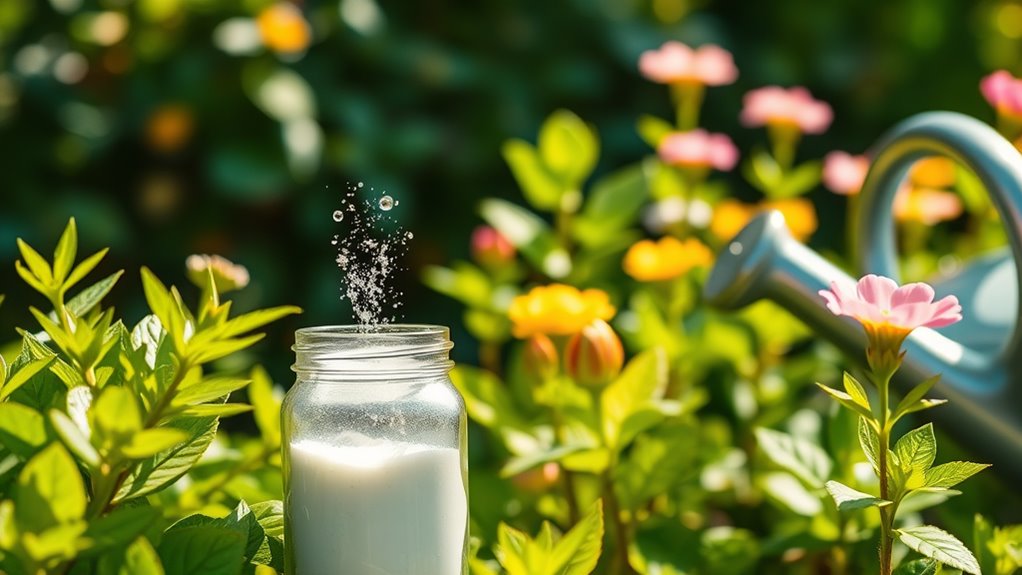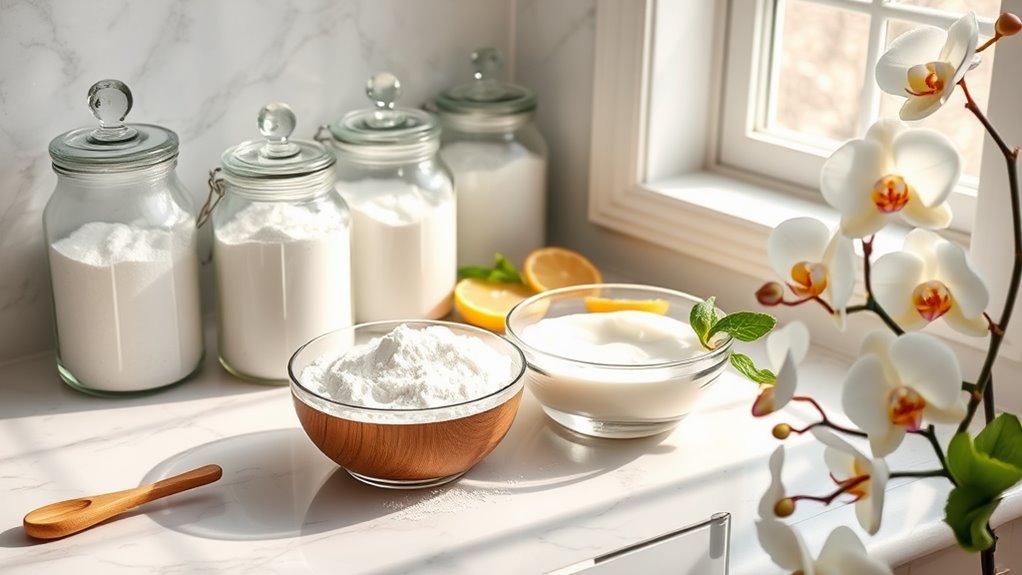Can Baking Soda Help Your Plants. Yes, and Here’s How
Did you know that nearly 30% of gardeners face challenges with plant diseases and pests each year? Baking soda, a common household item, can be an effective tool in your gardening arsenal. It not only helps combat fungal issues but also enhances growth and improves soil health. Understanding how to use this versatile ingredient can transform your gardening experience, leading to healthier plants and a more vibrant garden. Curious about how to get started?
Key Takeaways
- Baking soda prevents fungal diseases like powdery mildew and acts as a mild pesticide for plants.
- It enhances plant growth by improving nutrient absorption and promoting microbial activity in the soil.
- Regular application can help create an alkaline environment suitable for alkaline-loving plants.
- Use a diluted solution or dusting method to avoid overcorrection and salt buildup in the soil.
- Monitor soil pH and plant response after application to ensure optimal health and growth.
Understanding the Benefits of Baking Soda for Plants
Although you might think of baking soda as just a kitchen staple, it offers several benefits for plants that can enhance their growth and health.
One significant advantage is its ability to prevent fungal diseases, which can be particularly detrimental to plants like hydrangeas. By creating a solution of baking soda and water, you can spray it on the leaves to help combat powdery mildew and other fungal infections.
Additionally, baking soda can serve as a mild pesticide, deterring pests that threaten your hydrangeas. It also contributes to improving overall plant vigor by promoting a healthier environment.
Incorporating baking soda for hydrangeas, consequently, not only strengthens their resilience but also encourages vibrant blooms and lush foliage.
How Baking Soda Affects Soil Ph
When you add baking soda to your garden, it can markedly alter the pH level of the soil, making it more alkaline. This change occurs because baking soda, or sodium bicarbonate, releases sodium ions that interact with hydrogen ions in the soil.
By reducing the acidity, you create a more favorable environment for certain plants that thrive in alkaline conditions, such as lilacs and asparagus. However, it’s important to monitor the pH level regularly, as excessive use can lead to soil imbalances.
A pH between 6.0 and 7.5 is generally ideal for most plants. To achieve the best results, mix baking soda with water and apply it sparingly to avoid drastic shifts in soil chemistry.
Using Baking Soda to Combat Fungal Diseases
Baking soda is an effective natural remedy for combating fungal diseases in your garden. Its alkaline properties can help neutralize the acidic environment that fungi thrive in.
Here’s how you can use it:
-
Preventive Spray: Mix 1 teaspoon of baking soda with 1 quart of water and spray on affected plants weekly.
-
Powdered Application: Dust baking soda directly on leaves to deter powdery mildew.
-
Soil Treatment: Incorporate baking soda into the soil before planting to reduce fungal spores.
-
Combine with Soap: Add a few drops of liquid soap to your baking soda solution to enhance adherence to plant surfaces.
Enhancing Plant Growth With Baking Soda
Using baking soda can greatly enhance your plant growth by improving nutrient absorption and regulating pH levels in the soil.
This simple compound not only fosters a more balanced environment for your plants but also helps prevent diseases that can hinder their development.
Nutrient Absorption Improvement
Although many gardeners focus on soil quality and watering practices, enhancing nutrient absorption is equally essential for plant growth. Baking soda can play a crucial role in this process. Here’s how it helps:
-
Sodium Source: Baking soda provides sodium, which aids in the absorption of nutrients like potassium and magnesium.
-
Carbonate Addition: It adds carbonates to the soil, promoting better microbial activity that helps break down organic matter.
-
Improved Ion Exchange: The presence of baking soda enhances the ion exchange capacity of soil, allowing plants to take up more nutrients.
-
Disease Resistance: Healthy plants can absorb nutrients more efficiently, and baking soda’s antifungal properties help prevent diseases that hinder growth.
Integrating baking soda into your gardening routine can greatly boost nutrient absorption and plant health.
Ph Level Regulation
Maintaining the right pH level in your soil is vital for ideal plant growth, as it directly affects nutrient availability.
Baking soda, or sodium bicarbonate, can help you regulate soil pH, especially if your soil is too acidic. By dissolving a tablespoon of baking soda in a gallon of water and applying it to your soil, you can gradually raise the pH level.
This increase in alkalinity allows for better nutrient absorption and promotes healthier root development. However, it’s important to test your soil’s pH before application to avoid overcorrection.
Regular monitoring guarantees you maintain a favorable environment for your plants, leading to enhanced growth and productivity. Always follow up with additional testing after treatment for best results.
Disease Prevention Benefits
When it comes to enhancing plant growth, baking soda offers valuable disease prevention benefits that can help keep your garden thriving. By using baking soda, you can create a healthier environment for your plants and deter various diseases.
Here are some ways baking soda can aid in disease prevention:
-
Fungal Inhibition: Baking soda can help suppress the growth of fungal pathogens.
-
Powdery Mildew Control: A baking soda solution can effectively combat powdery mildew on leaves.
-
pH Regulation: It can help maintain a balanced pH, making plants less susceptible to disease.
-
Natural Antifungal: Baking soda acts as a natural antifungal agent, protecting your plants from infections.
Incorporating baking soda into your garden routine can greatly enhance plant health and resilience.
Applying Baking Soda for Pest Control
If you’re looking for an effective and natural way to manage pests in your garden, applying baking soda can be a game-changer. This household staple acts as a natural insecticide, particularly against soft-bodied pests like aphids and spider mites.
To use it, mix one tablespoon of baking soda with a quart of water and a few drops of dish soap. Spray this solution directly onto the affected plants, ensuring thorough coverage. The baking soda disrupts the pests’ cell membranes, leading to dehydration and death.
Additionally, it can deter fungal growth that attracts pests. Remember to test a small area first, as some plants may react differently. Regular applications can help maintain a pest-free garden naturally.
Best Practices for Using Baking Soda in Your Garden
To get the most out of baking soda in your garden, it’s crucial to follow best practices that maximize its benefits while minimizing potential risks.
Here are four key guidelines:
-
Dilute Properly: Mix one tablespoon of baking soda with a gallon of water for effective pest control and fungal prevention.
-
Test Soil pH: Before application, check your soil’s pH. Baking soda can raise pH levels, so use it cautiously if your soil is already alkaline.
-
Apply Sparingly: Use baking soda every few weeks rather than daily to avoid salt buildup in the soil.
-
Monitor Plant Response: Keep an eye on your plants after application. If you notice any adverse effects, discontinue use immediately.
Following these practices guarantees your garden thrives while utilizing baking soda effectively.
Tips for Specific Plants: Hydrangeas and Beyond
Baking soda can benefit a variety of plants, including hydrangeas, by adjusting soil pH and preventing fungal diseases.
For hydrangeas, mix one tablespoon of baking soda with a gallon of water and apply it to the soil to encourage blue blooms by lowering pH. Additionally, a baking soda solution can deter powdery mildew; spray it directly on affected leaves in early morning.
For tomatoes, apply a baking soda mixture to prevent blight; combine one tablespoon with a gallon of water and spray the foliage.
For roses, you can use a similar solution to combat black spot.
Always test a small area first to verify your plants respond positively before widespread application. Happy gardening!




